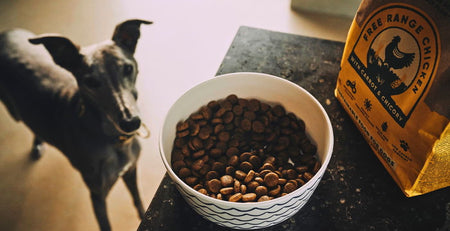If you've noticed that your dog is scratching excessively or experiencing digestive issues, it might be more than a passing phase. Like us, dogs can suffer from food allergies, and it’s your duty to educate yourself about them.
We’ll discuss the most common dog food allergies and break down the signs, diagnosis, and treatment options available to ensure your canine companion lives a happy and healthy life.
Dog food allergy signs
Symptoms often mimic other health issues, so identifying dog food allergies can be tricky. However, there are a few can’t-miss signs to note:
Persistent itching and scratching, particularly around the face, ears, and paws.
Red, inflamed skin, sometimes accompanied by rash or hives.
Diarrhoea, vomiting, or excessive gas.
Chronic ear infections or inflammation.
Hair loss or dull, brittle coat.
Most common dog food allergens

Some ingredients are more likely to trigger food allergies in dogs than others. Common allergens include:
Beef
It may seem like a staple protein in most dog foods, but some pups can develop sensitivities to beef proteins.
Symptoms of a beef allergy can vary from itching and scratching to vomiting and diarrhoea.
If you suspect your dog has a beef allergy, consider switching to a dog food that uses alternative protein sources like lamb or fish.
Chicken
Dogs with a chicken allergy may show similar symptoms to those with beef allergies, including skin irritation, digestive issues, and ear infections.
Fortunately, many chicken-free dog food options are available, making it easier to find a suitable alternative for your furry friend.
Dairy
Although your dog may enjoy an occasional ice cream lick, dairy products can trigger allergic reactions.
Lactose is often difficult for dogs to digest, leading to symptoms like diarrhoea, gas, and bloating.
If your dog experiences digestive upset after consuming dairy products, it's best to avoid them altogether and opt for lactose-free alternatives.
Eggs
Eggs provide a source of high-quality protein and essential nutrients. However, some dogs may develop allergies to egg proteins, resulting in symptoms such as itching, hives, and gastrointestinal distress.
If your dog shows signs of an egg allergy, consider consulting with your vet for personalised dietary recommendations.
Corn and wheat
Corn is a common ingredient in many dog foods, serving as a source of carbohydrates and fiber, yet it's also a common allergen for dogs.
Wheat is another grain that can cause allergic reactions. Although it’s typically used as a filler in lower-quality dog foods, it can also be found in treats.
Dogs with wheat allergies may experience itching, redness, and inflammation, particularly around the face, ears, and paws.
If you suspect your dog has a corn or wheat allergy, opt for grain-free dog food options or those formulated without corn to minimise the risk of triggering an allergic reaction.
 |
 |
 |
 |
Dry dog food |
Wet dog food |
Puppy food |
Treats |
How dog food allergies are diagnosed
If you suspect your dog may be suffering from food allergies, the first step is to schedule an appointment with your veterinarian.
Your vet will thoroughly examine your dog's medical history and symptoms to determine the best course of action. Common next steps involve:
Elimination diets
This involves removing potential allergens from your dog's diet and gradually reintroducing them occasionally, monitoring for any adverse reactions.
This helps to isolate the specific ingredients that may be causing the allergic reaction.
Keeping a food diary
While conducting an elimination diet, keeping a detailed food diary to track your dog's progress and any changes in their symptoms is crucial.
Record what your dog eats, any treats or table scraps they may consume, and any reactions or symptoms they experience.
This information will be invaluable for your vet in identifying patterns and determining which ingredients your dog may be allergic to.
Allergy testing
Your vet might recommend allergy testing to help pinpoint the specific allergens triggering your dog's symptoms.
Allergy testing can be done through blood tests or skin prick tests, which detect the presence of antibodies associated with allergic reactions.
Blood tests measure the levels of immunoglobulin E in your dog's bloodstream in response to various allergens.
Skin prick tests involve applying small amounts of potential allergens to your dog's skin and observing for any signs of an allergic reaction.
Treatment options for dog food allergies
Once diagnosed, it’s time to start treatment. Options may include:
Switching to hypoallergenic dog food formulated to exclude common allergens.
Prescription medications such as antihistamines or steroids to alleviate itching and inflammation.
Incorporating supplements like omega-3 fatty acids to support skin health and reduce inflammation.
Alternative therapies
While traditional methods like dietary changes and medication play a crucial role in managing dog food allergies, emerging treatment methods offer additional options for pet parents seeking a holistic approach.
Probiotics: A gut-friendly solution
Probiotics promote a healthy balance of gut flora in both humans and dogs. These microscopic organisms strengthen the immune system and improve digestive health, making them a promising therapy for dogs with food allergies.
Introducing probiotics into your dog's diet can support their gut health and potentially reduce the severity of allergic reactions.
Potential Side Effects
Probiotics are generally safe for dogs, but potential side effects may occur when introducing them for the first time or using high doses.
Common side effects include mild digestive upset such as gas, bloating, or diarrhoea as the dog's gut microbiome adjusts to the new bacteria.
In rare cases, dogs may experience allergic reactions to specific strains of probiotics, leading to symptoms like itching, swelling, or difficulty breathing.
It's essential to start with a low dose of probiotics and gradually increase it while monitoring your dog for any adverse reactions.
Prebiotics: Nourishing the gut microbiome
Prebiotics are non-digestible fibres that serve as food for beneficial bacteria in the gut. Prebiotics help create an environment that supports the growth of healthy bacteria.
Incorporating prebiotic-rich foods or supplements into your dog's diet can complement probiotic therapy and further promote digestive wellness.
Potential Side Effects
However, excessive consumption of prebiotic-rich foods or supplements may lead to gastrointestinal discomfort.
Immunotherapy: Targeting allergen sensitivity
Immunotherapy, also known as allergy shots, involves exposing your dog to small doses of the allergen over time to desensitise their immune system.
Even though this method is traditionally used to treat environmental allergies like pollen or dust, it’s now being explored as a potential treatment option for food allergies.
By gradually increasing your dog's tolerance to specific food allergens, immunotherapy aims to reduce the severity of allergic reactions and improve overall quality of life.
Potential Side Effects
In rare cases, dogs may experience more severe allergic reactions, known as anaphylaxis, which can cause difficulty breathing, vomiting, or collapse.
It's crucial to administer immunotherapy under the supervision of a veterinarian who can monitor your dog closely and intervene if any extreme reactions occur.
How genetics influence dog food allergies
Genetics is like a blueprint that determines how our bodies respond to things. Certain dog breeds have genes that make them more likely to react to certain foods.
Why some breeds are more susceptible
German Shepherds or Labs suffer more from chicken and soy allergies than other breeds.
That's because they have inherited traits that make them more susceptible. Think of it like inheriting your mom's curly hair or your dad's blue eyes—it's all in the genes.
Finding the clues
Thanks to scientific advances, researchers are starting to uncover specific genetic markers linked to dog food allergies.
Some genetic markers that researchers have investigated include variations within genes encoding:
Immunoglobulin E (IgE) is an antibody the immune system produces in response to allergens, including food proteins.
Histamine is a compound released during allergic reactions, contributing to symptoms such as itching and inflammation.
Cytokines are signalling molecules in immune responses, while inflammatory mediators contribute to inflammation.
The skin is a barrier to environmental allergens, including food proteins that may trigger allergic reactions.
These markers act like little signposts, guiding scientists to understand how allergies develop and how to treat them better.
Choosing the best food for dogs with allergies
Every dog is unique, and their dietary needs differ based on age, breed, and overall health. When selecting food for a dog with allergies, you need to consider their specific sensitivities and preferences.
Start by consulting with your vet to identify potential allergens and develop a plan to effectively manage your dog's diet.
Limited ingredient diets
One popular option for dogs with food allergies is a limited-ingredient diet (LID). These specialised formulas feature fewer ingredients, primarily focusing on a single protein source and minimal additional components.
By minimising the number of potential allergens present in your dog's diet, LID foods help reduce the risk of triggering allergic reactions.
Pros:
Simplified ingredient list
Ideal for elimination diets
Available in various formulations
Cons:
Limited nutritional variety
Higher cost
Potential for ingredient changes by manufacturers
Novel protein sources
Traditional protein sources like chicken or beef could be the culprit behind your dog's allergies. Switching to a diet containing novel protein sources can be beneficial.
Examples of novel protein sources include venison, duck, rabbit, or even exotic meats like kangaroo or bison.
Pros:
Reduced risk of sensitivities
Diverse options available
Suitable for rotational feeding
Cons:
Potential palatability issues for picky eaters
Risk of sourcing issues
Limited nutritional information
Choosing a single protein source
Selecting food with a single protein source could be the best solution for dogs with known protein allergies. Sticking to a single protein source can reduce the risk of triggering an allergic reaction and help alleviate your dog's symptoms.
Pros:
Simplified dietary management
Ideal for dogs with known sensitivities
Suitable for dogs with medical conditions
Cons:
Limited flavour options
Potential for nutrient insufficiency
Difficulty in finding suitable options
Long-term management of dog food allergies
Living with a dog who suffers from food allergies can be challenging, but with the right long-term management strategies, you can help your trusty companion live a happy and healthy life.
Maintenance diets
Once you've identified your dog's food allergies, you must maintain a diet supporting their well-being.
Many pet owners succeed with hypoallergenic or limited-ingredient diets, which feature carefully selected ingredients to minimise the risk of triggering allergic reactions.
Monitoring protocols
Regular monitoring is crucial for managing dog food allergies effectively. Keep a close eye on your dog's symptoms and behaviour, noting any changes or flare-ups.
It's also important to monitor your dog's weight and skin condition, as food allergies can manifest in ways beyond digestive upset or itching.
Preventing relapses and new allergies
Preventing relapses and new allergies requires diligence and proactive measures. Here are some strategies to consider:
- Stick to the prescribed diet: Avoid feeding your dog table scraps or treats that contain ingredients known to trigger allergic reactions.
- Gradual introductions: If you need to introduce new foods or treats into your dog's diet, gradually monitor for any adverse reactions.
- Regular check-ups: Schedule regular visits with your veterinarian to monitor your dog's health and discuss any concerns or changes in their condition.
- Environmental allergens: Besides food allergies, dogs can also be sensitive to environmental allergens like pollen or dust. Minimise exposure to these triggers to reduce the risk of allergic reactions.
- Consistent flea control: Flea allergies can exacerbate existing food allergies, so keeping your dog protected with regular flea control measures is essential.
Frequently asked questions (FAQs)
How long should the food elimination trial go on?
Vets recommend running the trial for 8–12 weeks to ensure accurate results.
What is the correlation between Atopic Dermatitis and Food Allergies?
Up to 35% of dogs allergic to environmental substances are also hypersensitive to proteins in food, emphasising the co-occurrence of atopic dermatitis and food allergies in dogs.
Conclusion
Understanding and managing common dog food allergies is advisable to maintain your dog's health. By recognising the signs, seeking a proper diagnosis, and implementing appropriate treatment measures, you can help your furry friend enjoy a symptom-free life.
Always consult your veterinarian for personalised guidance and support tailored to your dog's needs. Improve your dog's well-being today by exploring our carefully curated range of dog food options tailored to accommodate various sensitivities and preferences.













